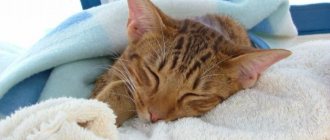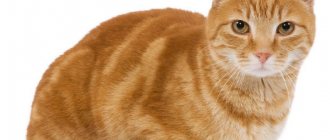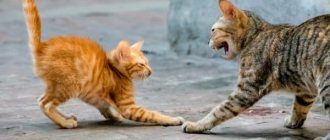02/25/2021 17,042 Diseases and treatment of cats
Author: Olga
Each cat has its own character. It often manifests itself in her “talkativeness.” There are pets that constantly try to attract attention by purring or meowing. But even if a cat doesn’t vocalize often, as soon as he loses it, any owner will notice it. The article discusses the reasons why a cat loses its voice and provides recommendations for solving this problem.
[Hide]
Description
The appearance of hoarseness is a disruption in the functioning of the vocal cords, swelling of the throat, and the growth of a tumor when it puts pressure on surrounding tissues. The voice may change - it becomes rattling, hoarse. Symptoms appear periodically or constantly. Sometimes the voice disappears completely. This may be preceded by anesthesia (used during the period of sterilization, castration, and other operations). While the pet returns to consciousness, it is weak and cannot make sounds. This condition goes away on its own without treatment.
How does voice loss manifest in cats?
Every cat owner knows well when the pet uses its sound activity. Typically, pets use their voice to convey certain information:
- ask for food, reminding you that feeding time has arrived;
- asked to leave or enter the room;
- remind you of yourself, demanding attention;
- signal the onset of readiness for procreation.
If in a familiar situation nothing is heard instead of the usual “meow,” the owner should pay attention to the cat. If an animal opens its mouth, but the sound is either very quiet or absent at all, it means that its voice has disappeared. When the problem does not go away after a few hours, it is worth looking for its cause.
Causes
Most often, the cause of hoarseness in an animal is viral and infectious diseases. Periodically occur against the background of hypothermia or a cold. For example, if in cold weather the pet walked for a long time on the street. Viral diseases are transmitted by airborne droplets.
Causes leading to hoarseness
| Disease or provoking factors | Description of the pathology |
| Otitis | Inflammation of the middle or inner ear with subsequent complications. Otitis media appears in cats exposed to drafts or due to infectious pathologies. The disease also appears in pets that are poorly cared for by their owners. Wax begins to accumulate in the ears, hair grows, and foreign objects can get into the ear canal. |
| Rhinotracheitis | Viral pathology affecting the respiratory system. Otherwise, the pathology is called feline herpes, caused by the FHV-1 virus. More often the disease affects kittens or young pets, less often it manifests itself in adults. |
| Laryngitis (sore throat) | The cause of hoarseness is inflammation of the throat mucosa, leading to swelling of the larynx. This affects the ligaments and the cat cannot make normal sounds. |
| Calcivirosis | The disease even leads to complete loss of voice. The mucous membranes of the mouth, upper respiratory tract, nose, and larynx are affected. Severe pathology provokes the appearance of arthritis or pneumonia. Cats get sick more often in houses where many animals live. Calcivirosis (like plague) is always accompanied by muteness and hoarseness. |
| Allergic reactions | This is accompanied by swelling of the throat. The clearance decreases, it becomes difficult for the animal to breathe, the voice changes to hoarse, and may disappear completely. Swelling is dangerous because it blocks breathing and leads to death. Your cat should be taken to the vet immediately at the first sign of hoarseness. |
| Anaphylactic shock | This is the most dangerous type of allergic reaction. The larynx swells rapidly, the voice is lost, and sometimes the owner may not have time to take the pet to the veterinarian. |
| Intoxication of the body | Poisoning can be caused by food, chemicals, insect poison, and disinfectants. |
| Getting foreign objects into the mouth | Mechanical damage to the walls appears. More often they are injured by toys or fish bones; they may swallow a spruce needle or twig. Sometimes the wound becomes inflamed, then, in addition to hoarseness, irreversible processes begin in the body. |
| Rabies | This is a fatal viral disease. The virus is transmitted through saliva. If vaccination is not carried out on time, the pet dies. |
| Dry or dirty air | The voice may begin to hoarse from the air filled with tobacco smoke. Nicotine has a negative effect on the ligaments. My throat is dry. The animal begins to wheeze and cannot utter sounds at all. Very dry air has the same effect. |
Hoarseness sometimes becomes a sign of the appearance of serious pathologies - leukemia, immunodeficiency. The diseases are deadly and treatment must be started as quickly as possible. However, only a veterinarian can carry out the diagnosis. Some consequences (for example, wounds of the larynx, purulent inflammation) appear for a long time in the form of wheezing. Stress, emotional distress, and travel can lead to hoarseness.
First aid at home
If your cat has lost her voice, you should not ignore it. It is necessary to immediately examine the animal's mouth. If you find a foreign object in your throat, you must remove it immediately. But you should do this yourself only if the owner is sure that his actions will not harm the animal even more.
If you cannot get the foreign object out on your own, you should immediately contact a veterinarian. You should not delay this, because a sharp object can get into the gastrointestinal tract, and then the animal will face more serious consequences.
If the cat's throat looks good: there is no damage or inflammation, and there are no other symptoms of the disease, nothing needs to be done. You should wait a little and watch the cat. If everything is normal, then the voice will soon recover on its own. If the animal does not make any sounds for a long time, it is better to go to the clinic for a preventive examination.
Treatment depending on the cause
Treatment for a hoarse voice directly depends on the cause of the symptom. If it is a tumor, then therapy is aimed at eliminating the main pathology. When the cause is a foreign body in the throat, it is removed by a veterinarian in a hospital setting. Removing the item yourself may cause serious complications or worsen the condition. Injections, IV drips, anesthesia, and wound treatment may also be required.
Reason: diseases
Vaccination is used to treat viral diseases (rabies, distemper, etc.). The cat is vaccinated, which prevents the spread of pathology and provokes the appearance of antibodies. For angina, Diazolin and Tavigil are given, which reduce swelling and pain. The dosage is calculated from the children's version, taking into account the weight of the pet.
Reason: dehydration
When a cat becomes dehydrated, the mucous membranes dry out. As a result, it becomes painful for the animal to swallow food, the surface may crack, wounds appear, and the meowing becomes hoarse. To avoid such manifestations, it is important to ensure that the cat has clean water available.
Reason: allergies
To eliminate allergy symptoms, you must first determine what caused the reaction. Symptoms are triggered by food, chemicals, and air fresheners. Allergies can be caused by tobacco smoke. In this case, it is necessary to humidify the air daily. In other cases, the veterinarian prescribes antiallergic drugs (for example, Suprastin). The products are selected taking into account the characteristics of the body and the allergen.
Reason: poisoning
If a hoarse voice appears due to poisoning with toxic substances, you need to give the animal fresh milk. When he cannot drink on his own, pour the product into his cheek. Milk can be replaced with a decoction of chamomile, yarrow or St. John's wort or saline solution. Before examination by a veterinarian, a sorbent is given.
Sometimes hoarseness in cats is associated with the period of mating games - the animals lose their voice. Then it recovers on its own. However, if hoarseness is accompanied by the presence of additional negative symptoms, the pet should be shown to a doctor. This will avoid complications, identify serious pathology in time, prescribe timely treatment, and sometimes save the cat’s life.
Blocking of the pharynx with a foreign object
An object, a piece of food, or a sharp bone getting stuck in a cat's throat is a common reason why she loses her voice or develops severe hoarseness. The situation is complicated by the fact that the animal is not only unable to independently free itself from a foreign body, its fear, desperate, instinctive attempts to remove the object by coughing or vomiting lead to severe trauma to the tissues of the respiratory organs, larynx, and esophagus. The presence of such damage contributes to the development of inflammatory processes and can lead to prolonged absence of voice.
The owner himself can help the pet - after securely fixing the animal with tweezers, you can try to remove the object from the throat. The owner's movements should be as careful as possible. If you are not confident in the safety of independent manipulations, you need to consult a specialist. To prevent the development of a dangerous situation, it is necessary to check the cat’s diet, avoid the presence of bones or larger pieces in the food, and do not leave small household items in the animal’s free access.
The cat is choking and wheezing: what to do
You need to open the mouth and pull the tongue forward, check the throat for foreign objects that should be removed, including mucus or vomit. This will help clear your airways. To do this, hold the cat by its hind legs and raise its head.
Important! If you suspect a spinal injury, you should not lift or move the animal. If removal of the foreign body does not help, you must begin first aid.
If removal of the foreign body does not help, you must begin first aid.
First aid for respiratory arrest
Step-by-step instruction:
How to give artificial respiration to a cat
Start artificial respiration: lay the cat on its side, pull the tongue forward, cover the mouth with your hand and straighten the neck. Air is inhaled through the cat's nose every 3 seconds.
It is important that the chest rises, but does not arch from excess inhaled air. During artificial respiration, you need to check for a heartbeat. If the heart is beating but there is no breathing, you need to inhale air at a rate of 10 breaths per minute until the cat breathes on its own. If you are completely sure of cardiac arrest, begin chest massage. If respiratory arrest is detected and resuscitation begins, it is important that someone call a veterinarian or take the cat and its owner to the clinic.
Important! Cardiopulmonary resuscitation should not be performed if the cat is conscious.
Instructions on how to perform chest compressions on a cat
Visit to a specialist
The veterinarian will determine exactly why the animal began to show anxiety, and for what reason problems with the speech apparatus arose. In most cases, the problem is solved in a clinical setting, where the necessary equipment and tools are available. The specialist is able to do everything possible to normalize the pet’s condition. The owner needs to listen carefully to all the recommendations, confirm the symptoms and be able to help the cat afterwards at home.
Help in hospital
Varieties
If the owners find that the cat wheezes when he breathes, wheezing and other pathological noises are recorded, then it is worth taking the pet to the veterinarian. Such a violation is divided into several types, presented in the table:
| Type | Peculiarities |
| Fine bubbles | The pathological sound is a consequence of the collapse of small air balls that are formed during sputum |
| Such wheezing is heard when the pet is sleeping or awake, and is characteristic of bronchitis, pneumonia and pulmonary infarction. | |
| Medium bubble | Reminds me of the sound of air blown through a tube |
| Observed with inflammation of the bronchi, which is associated with abundant accumulation of mucus | |
| Large-vesicular | Can be listened to without special devices |
| The cat exhibits noisy breathing with severe wheezing, and the pet can often burp liquid accumulated in the lungs | |
| Caused by pulmonary edema |
https://youtube.com/watch?v=_f7JN2cIdrI










